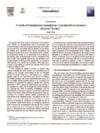Background
The concept of physical literacy (PL) is gaining popularity within public health and physical education circles. However, little is known about the relationship between perceived and actual PL levels among school-aged children. The aim of this study is to explore the associations between perceived and actual levels of PL of primary school students in China.
Methods
A total of 327 children (153 boys and 174 girls) with a mean (SD) age of 10.0 (±1.0) years were included for analysis. PL perceptions were measured using the Perceived Physical Literacy Instrument. Children’s actual level of PL was objectively assessed by the Chinese version of the Canadian Assessment of Physical Literacy, 2nd edition, which consists of four domains: Daily Behaviour, Physical Competence, Motivation and Confidence, and Knowledge and Understanding. Pearson’s correlation coefficients were calculated to examine the relationship between students’ perceived and actual PL levels, whereas Multivariate Analysis of Variance (MANOVA) was calculated to investigate the gender, relative age differences, and interaction effect (2 × 4) on perceived and actual PL levels respectively.
Results
Significant correlations were observed between the perceptions and actual PL scores in both boys (r = .46, p < .01) and girls (r = .41, p < .01). Low to moderate significances were shown between each domain of perceived PL and actual PL (from .16 to .49). Further MANOVA results revealed that there were significant gender differences in the Daily Behaviour domain of actual PL (F (1, 319) = 30.15, p < .001, Wilks’ Λ = 540.88, η2 partial = .09). Overall, boys had both higher actual PL scores (58.9) and PL perceptions (37.3) than girls. Neither relative age effect nor interaction effect (2 × 4) was observed for the current participants in all the variables.
Conclusions
This study is the first to examine the associations between the perceived and actual levels of PL in Chinese children. Additional studies should explore the importance of children’s perceptions of PL when assessing the actual level of PL in physical education and health settings. Girls should be more encouraged by PE teachers to participate actively in physical activities in the school environment.



Responses